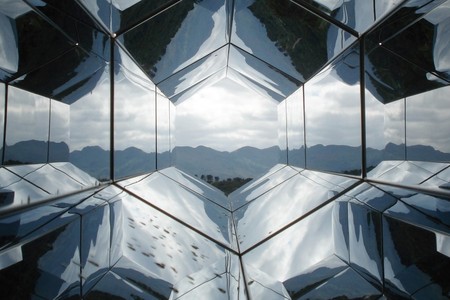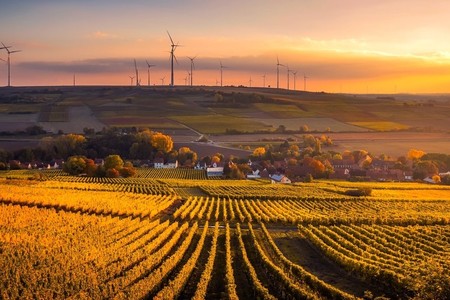This edition of the Tomorrow Times reveals insight into the latest innovations and curiosities in sustainability. Read on to learn about the practice of agrivoltaics, the need for digitalization to ensure circular economies, and new recycling approaches.
Additionally, discover how biomimicry has led to spectacular breakthroughs in healthcare, how self-driving cars can create memories, and how new building materials and policies are actively shaping the built environment.
Stay curious, keep up to date, and get inspired, all in a quick read.
Follow these periodical updates of tomorrow's sustainability news today by subscribing to the Tomorrow Times.
Energy and Environment

- Combining crops and solar panels allowing Kenya to ‘harvest the sun twice’
Kenya's first agrivoltaics array has opened, as the result of a combined effort from different Universities and organizations, helping overcome the common conflicting ideas and designation of land use. By utilizing specially designed PV set-ups, this emerging practice ensures crops are provided systems for both shade and rainwater harvesting. This offers more nurturing and efficient environments for food production compared to open fields and direct sunlight.
- The Oder's mysterious fish die-off and triggered systemic dynamics
The Oder River, bordering Germany and Poland, has recently experienced unexplained mass fish deaths. Recent news points to a cascade of systemic interrelations, such as low water levels and high temperatures, dwindling oxygen levels, industrial discharge, salinity, and the proliferation of toxic algae. The IGB, Germany's most significant freshwater research center, has published recommendations on how to ensure the recovery and sustainable use of the river.
- Preserving our long-lasting carbon removal and storage is vital
A recent study on California's wildfires has found that nearly one-fifth of the following century's carbon "buffer pool" was destroyed in less than a decade. This loss highlights the importance of preserving carbon removal and storage projects such as geological reservoirs or creating stable minerals, as stated in the Oxford Principles for Net Zero Aligned Carbon Offsetting. Increasing the amount of stored carbon ensures it remains out of the atmosphere and helps support credible net zero claims.
Business and Economy

- How digitalization can help enhance the global circular economy
Digitalization's ability to facilitate business ecosystem collaboration across geographies and organizations is central to realizing a global circular economy. According to the World Economic Forum, a digital shift is already taking place, offering entire supply chain and ecosystem transparency and new opportunities in resource efficiency and stakeholder engagement. In turn, this encourages the innovation in alternative income streams and waste reduction needed to make that change.
- Post-conflict societies provide opportunity for systemic sustainability
Established in 2017, Mosul's debris recycling facility was used to support the clean-up of vast amounts of debris created by the conflict. It is now an integral part of the city, the core of a project that promotes recovery and livelihoods by drawing on principles of a circular economy, wherein waste and land pollution is limited through production processes that reuse and repurpose materials for as long as possible
- Mining of e-waste offers lucrative business opportunities
Precious metals are needed to produce many of our modern gadgets and as many are tipped to run out during the coming century, their use is currently unsustainable. Scientists are calling for the recycling of this electronic waste to urgently be ramped up. As it stands, non-recycled e-waste is estimated to contain recoverable materials to a value of around US$55 billion. Not only is it good for sustainability, it can also be good for business.
Science, Technology and Design

- Biomimicry continues to revolutionize the medical field
The Wyss Institute has come up with a strong and flexible hydrogel adhesive design that can seal wounds almost anywhere in the body. Researchers say the new robust hydrogel adhesive is "inspired by the glue secreted by a common slug that is biocompatible, flexible, and can stick to dynamically moving tissues even in the presence of blood."
- Technology helps self-driving cars develop and learn from 'memories'
Researchers have developed a way to help autonomous vehicles create 'memories' of previous experiences and use them in future navigation, especially during adverse weather conditions when the car cannot safely rely on its sensors.
This function is made possible with new technology based on LiDARimage scanning, and SQuaSH (Spatial-Quantized Sparse History) shared database. Until now, cars using artificial neural networks are in a "constant state of seeing the world for the first time."
- The 'green transition' must be a long-term, systemic process
There's no secret that producing renewable technologies often has a hidden 'dark side' to the type of material, quantity, and emissions. This is especially true when assessing short-term efficiency of transitions occurring in parallel. For example, the widespread uptake of EVs with a simultaneous adoption of renewables. Adopting systemic solutions, such as innovations in tech, infrastructure and options for energy storage in a series of steps can offer a more sustainable and regenerative pathway.
The Urban Environment

- The emergence of biobased low-carbon alternatives to concrete
As a critical building material, and the rapid growth of cities, associated emissions have doubled over the past 20 years. Biobased alternatives are a solution and, thankfully, are now becoming more readily available. Especially in combination with elements whose properties are fundamental for specific features such as foundations. Bio-cement made from algae is just one of the many emerging innovations.
- New ways of working reshape communities in rural Portugal
In Portugal, the government is offering up to €4,800 to persuade relocations to the countryside. The novel initiative is finding fertile ground thanks to the growth in popularity of new ways of working - exponentially driven and by the recent pandemic. Many employees and companies now find working remotely more productive and it’s having a positive outcome for remote communities.
- French law to boost rooftop vegetation and renewable energy
The French Parliament recently approved a law requiring all new buildings in commercial zones to be partially covered in plants or solar panels to generate electricity. Utilizing underused roof space is becoming increasingly common worldwide, due to the benefits in water management, biodiversity, reducing temperatures, and providing vital space for PVs.
This law is part of a more extensive democratic consultation process named The Climate and Resilience Act, which enshrines several provisions to help cities combat climate change.
Unexpected and Intriguing

- Wearable device tracks users' mental state to aid in communication
Researchers at New York University have created a wearable technology that measures an individual's electrodermal activity - a condition affected by such conditions as stress or excitement. An ingenious new technology, the device can be used to help people who have difficulties communicating, such as mentally disabled people or infants, more easily express how they are feeling.
- Investing in CERN helped develop much of our modern world
Switzerland's Large Hadron Collider (LHC), commonly called CERN, is the world's largest particle physics laboratory. It has been pivotal in developing countless everyday technologies, such as the internet, body imaging scanners, and cancer therapies. CERN is a prime example of how investing in big science benefits industrial innovation across society and various industries.
- Warming could be stopped for far less than global COVID stimulus costs
According to Professor Yuval Noah Harari, poor leadership is the fundamental factor accelerating global warming. The author of Sapiens, Homo Deus, and 21 Lessons for the 21st Century, Harari, is one of the few internationally prominent leaders on this topic. In this short talk, he reveals how hope still exists, and we can stop climate change - though it will take 2-5% of the global GDP investments. In comparison, during the first nine months of COVID-19, governments across the globe announced stimulus measures equivalent to almost 14% of GDP.
Read more, subscribe and contact
Follow this link to find previous editions and newsletters.
Click here to subscribe for all future editions.
Let us know if you've seen anything suitable to share in the Tomorrow Times
Oct. 10, 2022




